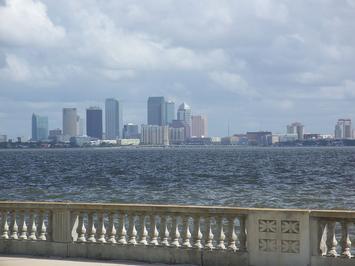
Mass transit may have taken the biggest hit from Covid-19, declining by 55% in the New York urban area, 43% in Los Angeles and 57% in Chicago, but car commutes also suffered. The latest INRIX Global Traffic Scorecard finds that US vehicle traffic to downtowns (central business districts) also declined by a substantial 44% in the pandemic year of 2020. According to Bob Pishue, an INRIX traffic analyst: “COVID-19 has completely transformed when, where and how people move. Government restrictions and the continued spread of the virus led to shifts in travel behavior seemingly overnight,” adding that “Morning commutes in cities across the world went without delay as people reduced auto and transit travel to offices, schools, shopping centers and other public spaces.”
There has been a good side to this reduction, which led to a “reduction in congestion has resulted in quicker commutes for essential workers, more reliable deliveries and streamlined freight movement, all of which are vital to the economy, ”Pishue further reported that “We expect downtown trips will continue to lag suburban and rural travel through 2021.”
Downtown Commuting Losses
INRIX provided downtown data for 25 US urban areas, and the one place where downtowns did best was in Florida. The sunshine state’s downtown economies held up the best. The smallest drop in downtown commuting from February 2020 to February 2021 was in Tampa-St. Petersburg, where travel to downtown Tampa declined 16%. Downtown travel declined 18% in Miami, 23% in Orlando, 26% in San Diego and 27% in Atlanta. By comparison, the average vehicle trip loss for the 25 downtowns was considerably larger, at 43% (Figure 1).
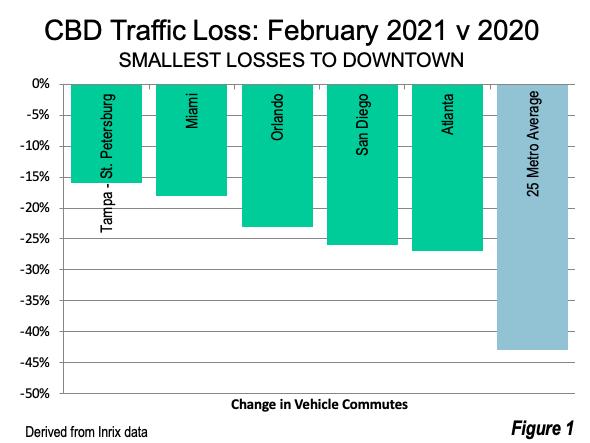
Portland, Oregon suffered the largest loss over the same period of time, at 66%. Portland was closely followed by San Francisco, with a 64% loss. The Washington (DC-VA-MD) urban area had a loss of 60%, followed by Detroit at 59% and Boston at 56% (Figure 2).

Downtowns in the nation’s three largest metropolitan areas also suffered significant losses in vehicle trips (Figure 3).
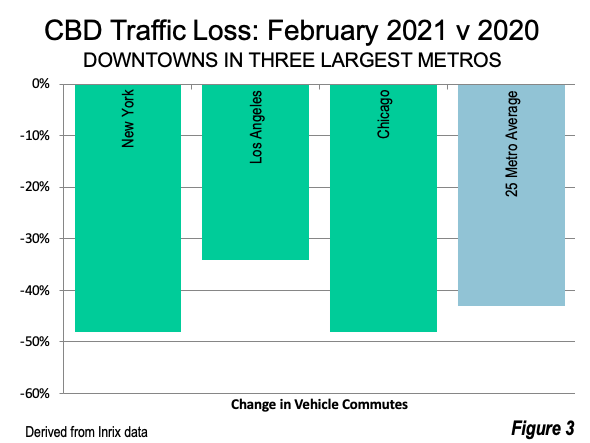
The largest downtown, in New York had a loss of 48 percent, worse than the 25 metro average of 43%. This loss was considerably less than many others, such as the Florida downtowns noted above. However, vehicle trips are not nearly so important in New York, where more than 75% of downtown commuting is by transit, rather than by car. The transit losses have been more severe, especially on the long distance commuter rail lines, which continue to operate at more than 75% losses, while the subway does little better at more than a 60% loss, as of April 16. The New York metro has the highest percentage of its employment in downtown (among the major metropolitan areas), at 20.2 percent.
The second largest downtown, in Chicago, also lost 48 percent of its vehicle trips. Downtown Chicago’s transit market share is also strong, at 46% (better than any other major CBD outside New York, San Francisco, Boston and Washington). Like New York, Chicago’s commuter rail ridership fell even further, more than 90 percent. Chicago has one of the largest downtown employment shares among the major metros, at 12.5%.
The Los Angeles metro, which trails only New York in population has a small downtown area for its size and lost a smaller 34% of its vehicle trips. Comprising only 2.6% of employment, downtown Los Angeles has a metropolitan employment share that is about one-eighth that of New York and one-fifth that of Chicago (Figures 4 & 5). Downtown Los Angeles has far less transit commuting than in the other two largest metros, with a rate of 23%. This is more than two thirds below New York and about one-half that of Chicago.
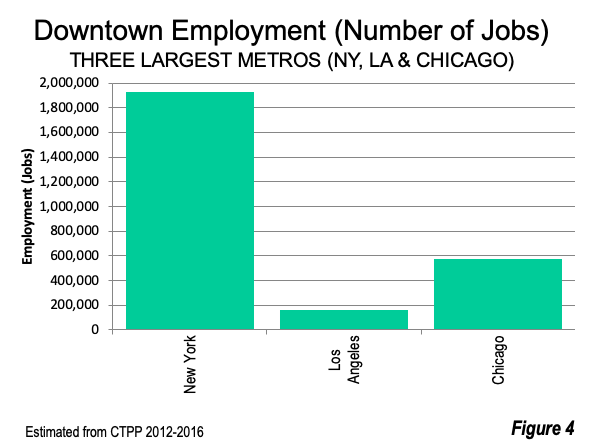

Downtown Commuting Recoveries
As economies have begun to open up, the three urban areas in which downtown oriented traffic had the least loss over the past year also had the largest recovery in traffic from April 2020 to February 2021.
Tampa-St. Petersburg recovered 79% of its downtown traffic from April to February. Miami recovered 76%, while Orlando experienced a 68% recovery. Atlanta recovered 67% of its traffic. St. Louis had the fifth best recovery, at 63% (Figure 6).
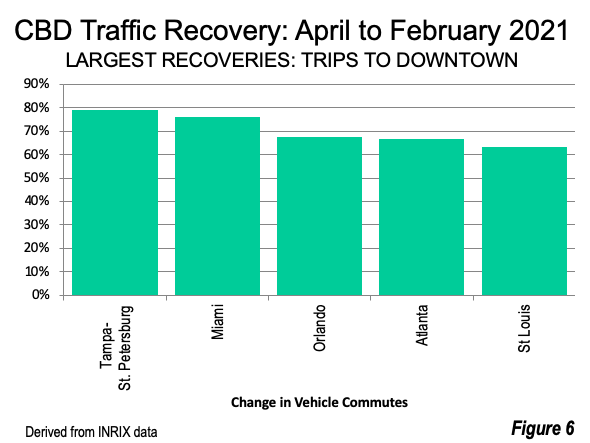
The smallest recovery was in Portland, which also had the largest decline (above) up only 14% from April to February, far worse than the other 24 metropolitan areas. More than automobile traffic has declined. Oregon’s largest newspaper, The Oregonian, reported an 80 percent drop in downtown holiday foot traffic over the holiday season compared to last year, which it attributed to the effect of remote work and protests.
San Francisco and Washington had the second and third worst recovery at 26% and 28% respectively. These two urban areas also had the second and third largest traffic volume over the past year (Figure 7).

The Challenge for Downtowns
INRIX summarized the challenges for downtown:
“Downtown areas experienced large decreases in trips throughout the day, as working from home, restaurant, entertainment, fitness and other brick-and-mortar closures, along with limits on gatherings, had an outsized effect in the densest parts of each region.”
Recoveries are likely to take longer in the downtown areas:
“Downtowns, the hardest hit areas by the pandemic due to the densification of people, employment, office buildings, restaurants and entertainment, are projected to be last to recover during the re-emergence period, lagging suburban and rural travel throughout 2021.”
This is not just a US phenomenon. INRIX noted similar international trends in the first two months of 2021 (Figures 8 & 9). A just released article in The Pulse notes similar trends in Australia’s downtowns provides a broad analysis of broader economic impacts.
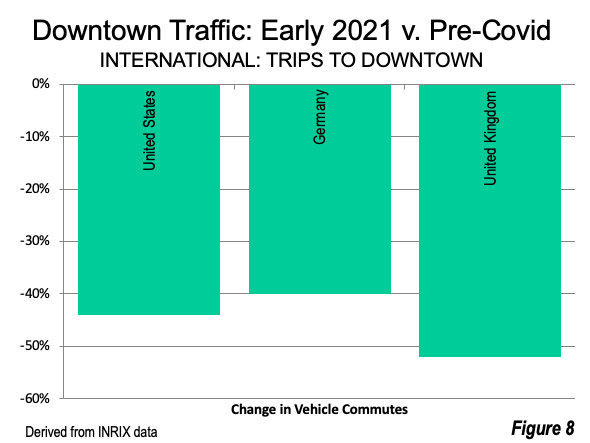
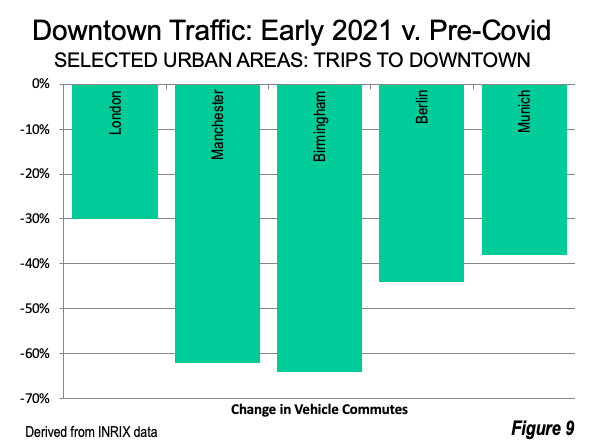
To be sure, downtowns everywhere will recover from their nadir. But the much of the exodus of work away from the densest employment centers, the largest downtowns, seems likely to continue to some extent for the foreseeable future.
Wendell Cox is principal of Demographia, an international public policy firm located in the St. Louis metropolitan area. He is a founding senior fellow at the Urban Reform Institute, Houston, a Senior Fellow with the Frontier Centre for Public Policy in Winnipeg and a member of the Advisory Board of the Center for Demographics and Policy at Chapman University in Orange, California. He has served as a visiting professor at the Conservatoire National des Arts et Metiers in Paris. His principal interests are economics, poverty alleviation, demographics, urban policy and transport. He is co-author of the annual Demographia International Housing Affordability Survey and author of Demographia World Urban Areas.
Mayor Tom Bradley appointed him to three terms on the Los Angeles County Transportation Commission (1977-1985) and Speaker of the House Newt Gingrich appointed him to the Amtrak Reform Council, to complete the unexpired term of New Jersey Governor Christine Todd Whitman (1999-2002). He is author of War on the Dream: How Anti-Sprawl Policy Threatens the Quality of Life and Toward More Prosperous Cities: A Framing Essay on Urban Areas, Transport, Planning and the Dimensions of Sustainability.
Photo: Downtown Tampa, Greatest sustained employment during the pandemic and the greatest recovery via Wikimedia under CC 3.0 License.












